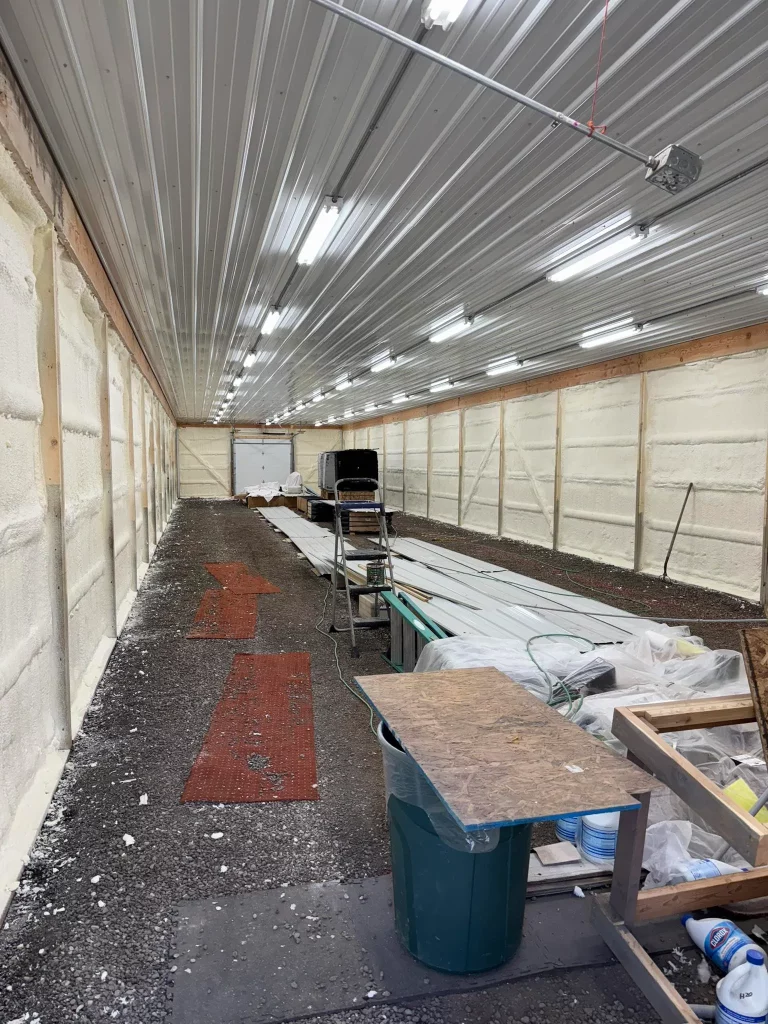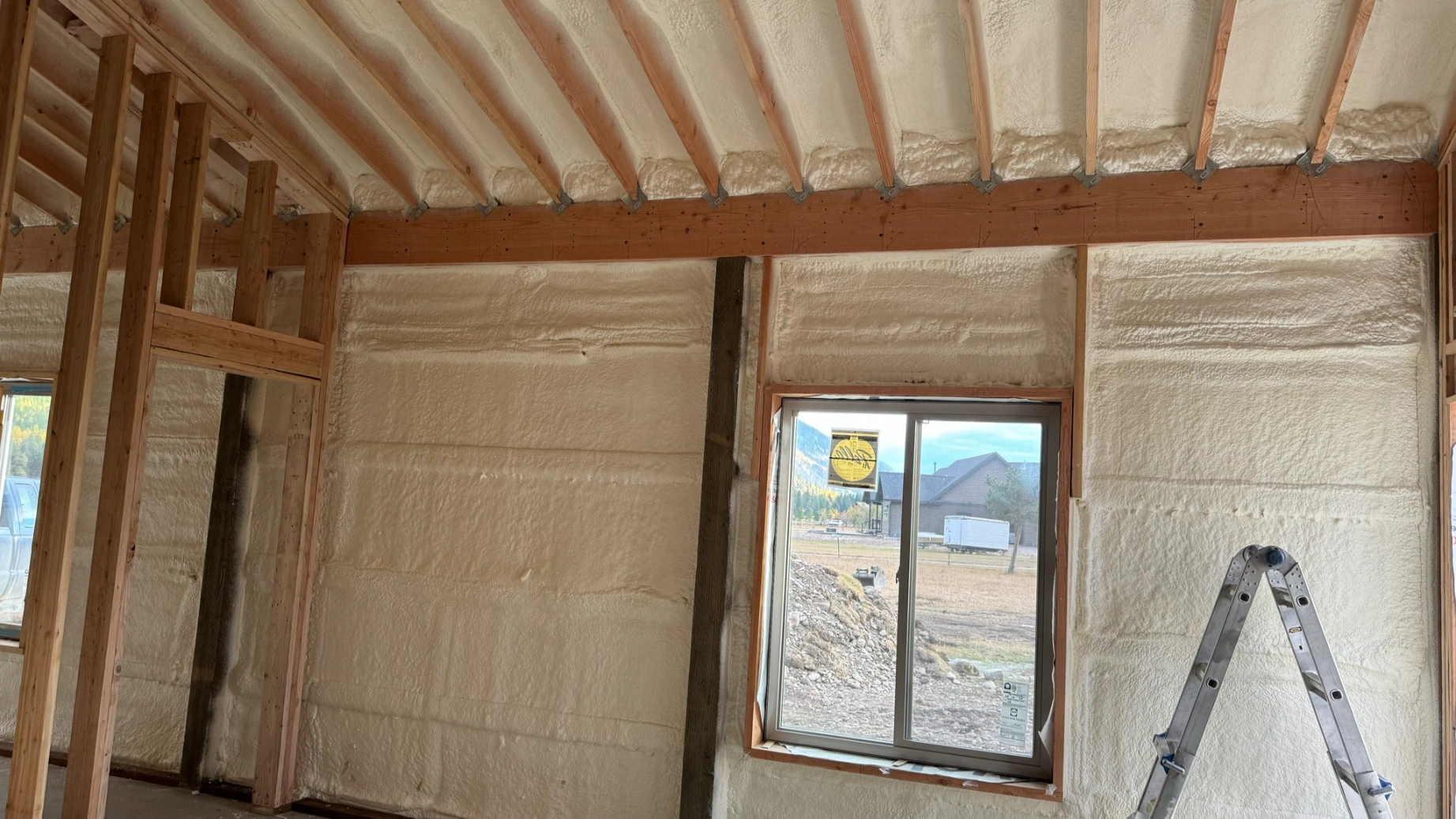

Spray foam insulation directly cuts energy bills by creating a near-perfect air seal. Unlike traditional insulation like fiberglass or cellulose, which only slows heat transfer, spray foam stops air leakage altogether. Since a significant portion of a home’s heating and cooling costs comes from air escaping through gaps and cracks, sealing them has an immediate and substantial impact. The U.S. Department of Energy explains that this combination of air sealing and insulation can reduce heating and cooling costs by creating a more stable indoor environment that requires less energy to maintain. This article will break down how this material works, compare its different forms, and outline the real financial benefits.
For a deeper understanding of how spray foam insulation can reduce energy costs and improve home comfort, read our full press release with detailed case studies here.
The information presented here is based on extensive field experience insulating homes and commercial buildings, providing a practical understanding of how spray foam performs in real-world conditions.
A home’s energy efficiency depends on two main things: resisting heat flow and preventing air movement. Most people are familiar with R-value, which measures an insulation’s ability to resist heat. While important, R-value alone doesn’t tell the whole story. Air leakage can undermine the effectiveness of even high R-value insulation.
Air finds its way through countless small openings in a building’s envelope, including around windows, electrical outlets, plumbing penetrations, and where the foundation meets the walls. As this air moves, it carries your heated or cooled air with it, forcing your HVAC system to work harder and longer. Spray polyurethane foam (SPF) expands upon application, filling every gap and crack to form a continuous, monolithic air barrier. This barrier is what truly sets it apart from batts or blown-in materials, which can leave gaps or settle over time.
By stopping uncontrolled air exchange, spray foam also helps manage moisture. Air carries water vapor, and when warm, moist air meets a cold surface inside a wall cavity, condensation can occur. This moisture can lead to mold growth and rot, but a proper air seal largely prevents this from happening.
Not all spray foam is the same. The two primary types, open-cell and closed-cell, have different properties and are suited for different applications. Understanding their differences is key to making an informed decision. Information from the Spray Polyurethane Foam Alliance confirms that closed-cell foam provides a significantly higher R-value per inch and acts as a vapor barrier, making it ideal for exterior walls and roofs. Open-cell foam is less dense, provides excellent sound attenuation, and is often used in interior walls.
Here’s a direct comparison of their key attributes:
| Feature | Open-Cell Spray Foam | Closed-Cell Spray Foam |
|---|---|---|
| R-Value per Inch | ~R-3.5 to R-3.8 | ~R-6.5 to R-7.0 |
| Air Barrier | Yes | Yes |
| Vapor Permeability | Permeable (allows vapor to pass) | Impermeable (blocks vapor) |
| Structural Rigidity | Spongy and flexible | Rigid and strong |
| Common Uses | Interior walls, soundproofing | Attics, crawl spaces, exterior walls |
Bonus Tip: For homeowners looking for the highest impact application, applying closed-cell spray foam to the rim joists in a basement or crawl space is a great starting point. This area is a major source of air leakage and heat loss, and sealing it can produce noticeable comfort and energy savings.
While choosing the right type of foam is crucial for a specific application, the ultimate goal for most homeowners is understanding the potential financial return.

The primary reason homeowners invest in spray foam is the potential for significant long-term savings. While the exact amount varies based on climate, home size, and existing insulation levels, the results are consistently positive. The U.S. Environmental Protection Agency’s ENERGY STAR program states that homeowners can save an average of 15% on heating and cooling costs by air sealing their homes and adding insulation in key areas like attics and crawl spaces. Because spray foam accomplishes both simultaneously, the savings can often be even greater.
For example, a poorly sealed attic can be a major drain on a home’s energy budget. In the summer, superheated air in the attic radiates down into the living space. In the winter, heated air from below escapes into the cold attic. Applying closed-cell spray foam directly to the underside of the roof deck creates a conditioned or semi-conditioned attic space. This brings the attic inside the home’s thermal envelope, drastically reducing the temperature differential and stopping the “stack effect,” where air is pulled up and out of the house.
Before committing to spray foam insulation, there are several practical factors to evaluate to ensure it’s the right fit for your property and budget.
Bonus Tip: Ask your installer about conducting a blower door test before and after the installation. This test measures the home’s airtightness in Air Changes per Hour (ACH). The results provide concrete data on how much the air sealing has improved, helping to quantify the project’s success.
Spray foam insulation offers a powerful solution for homeowners looking to make a serious dent in their energy bills. By providing both a high R-value and a superior air seal in a single application, it addresses the primary causes of energy loss in a home. While the initial cost is higher than some alternatives, the long-term savings, improved indoor comfort, and added structural benefits present a compelling case for it as a sound investment in a home’s performance and durability. The best approach is to evaluate your specific property’s needs and long-term goals to determine where it can provide the most benefit.
Understanding your home’s unique energy profile is the first step. A professional assessment can identify key areas of air leakage and heat loss, providing a clear roadmap for improvements. For a detailed evaluation, you can contact Wegner Insulation for a consultation. Reach out by phone at (406) 654-4636 or send an email to [email protected] to discuss your project. An expert evaluation ensures you get a solution tailored to your home’s specific needs for maximum energy savings and comfort.
The savings depend heavily on your home’s current condition, your local climate, and energy costs. However, many homeowners report reductions in their heating and cooling expenses ranging from 20% to over 40% after a complete spray foam installation.
For an average-sized home, insulating an attic or crawl space can typically be completed in one to two days. The foam cures quickly, and the area is usually safe to re-enter a few hours after the crew has finished and ventilated the space.
Like many building materials, spray foam is combustible. However, building codes require it to be covered by a 15-minute thermal barrier, such as half-inch drywall or a special intumescent paint, to prevent it from being exposed to open flames in living areas. When properly installed behind a thermal barrier, it meets all residential fire safety standards.
Federal, state, and local utility programs often offer incentives for energy-efficient home improvements. It’s a good idea to check the ENERGY STAR website and your local utility provider’s programs for current rebates or tax credits available for insulation upgrades.
When installed correctly by a qualified professional, spray foam will not damage your home’s structure. Closed-cell foam can add structural strength to walls and roof decks. The key is hiring an experienced contractor who understands building science.
Closed-cell spray foam is a moisture vapor barrier, meaning it blocks water vapor from passing through it. This prevents condensation from forming within wall cavities, which is a common cause of mold. Open-cell foam allows vapor to pass through, so its use depends on the climate and specific application.
.


